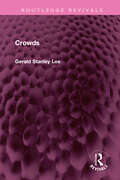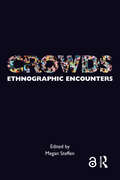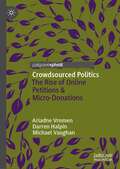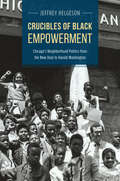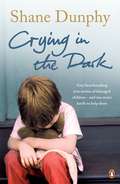- Table View
- List View
Crowds: A Moving-picture Of Democracy (Routledge Revivals)
by Gerald Stanley LeeThis book, first published in 1913, examines early twentieth century thinking on crowds and human nature. The imagination of crowds and the desire to be good, to be happy and successful, together with the wish for the new are all considered along with the changes in the politics and industry of the time.
Crowds (Routledge Revivals)
by Gerald Stanley LeeThis book, first published in 1913, examines early twentieth century thinking on crowds and human nature. The imagination of crowds and the desire to be good, to be happy and successful, together with the wish for the new are all considered along with the changes in the politics and industry of the time.
Crowds: Ethnographic Encounters (Encounters: Experience and Anthropological Knowledge)
by Megan SteffenWhat exactly is a crowd? How do crowds differ from other large gatherings of people? And how do they transform emotions, politics, or faith? In Crowds, contributors draw on their experiences and expertise to reflect on their encounters with crowds. Each chapter examines a particular crowd or conception of crowdedness to provide an analysis of how, when, where—and with whom—crowds form in different contexts, as well as their purpose and the practical effect the experience has on both the participants and their environment. The wide selection of case studies ranges from the crowds that form every year during the Hajj, to New Year celebrations in China, commuters on the Delhi metro, public prayer in Nigeria, online mobs in Bangladesh, and the crowds that have emerged during protest movements in Thailand and Syria. Crowds makes a key contribution to establishing an anthropological theory of crowds and will be an essential read for both students and researchers.
Crowds: Ethnographic Encounters (Encounters: Experience and Anthropological Knowledge)
by Megan SteffenWhat exactly is a crowd? How do crowds differ from other large gatherings of people? And how do they transform emotions, politics, or faith? In Crowds, contributors draw on their experiences and expertise to reflect on their encounters with crowds. Each chapter examines a particular crowd or conception of crowdedness to provide an analysis of how, when, where—and with whom—crowds form in different contexts, as well as their purpose and the practical effect the experience has on both the participants and their environment. The wide selection of case studies ranges from the crowds that form every year during the Hajj, to New Year celebrations in China, commuters on the Delhi metro, public prayer in Nigeria, online mobs in Bangladesh, and the crowds that have emerged during protest movements in Thailand and Syria. Crowds makes a key contribution to establishing an anthropological theory of crowds and will be an essential read for both students and researchers.
Crowdsourced Politics: The Rise of Online Petitions & Micro-Donations
by Ariadne Vromen Darren Halpin Michael VaughanThis book focuses on online petitioning and crowdfunding platforms to demonstrate the everyday impact that digital communications have had on contemporary citizen participation. In doing do, the book argues that crowdsourced participation has become normalised and institutionalised into the everyday repertoires of citizens and their organisations. Within the digitally-enabled shift in individual acts of participation, creating, signing and sharing online petitions and micro-donations have become a focal point because of the clear evolution from their offline and online counterparts.To illustrate their arguments the authors use an original nationally representative survey on acts of political engagement, undertaken with Australian citizens. Additionally, through detailed interviews and analysis of their web presence they show how advocacy organisations use online petitions within their repertoire of strategic actions. Lastly, they analyse the kinds of policy issues that mobilise citizens on crowdsourcing platforms, based on a unique dataset of 17,000 petitions from the popular non-government platform, Change.org. They contrast these mass public concerns with the policy agenda of the government of the day to show there is a disjuncture and general lack of responsiveness to this form of citizen expression.
Crowdsourcing for Innovation in Higher Education (Routledge Advances in Management and Business Studies)
by Regina Lenart-Gansiniec Łukasz SułkowskiSignificant disruption to the educational sector occurred due to the COVID-19 pandemic. This shed a light on the need for new delivery methods and greater collaboration, which has become urgent and obvious as existing structures and traditional channels have struggled to cope or shut down. Higher education institutions often fail to crowdsource successfully because crowds differ in how they are organized compared to traditional sourcing. Instead of managing, higher education institutions work with external contributors who self-select into the process. Crowdsourcing has significant potential to transform the education space by enhancing existing methodologies and offering innovative possibilities to develop new pedagogical techniques. This offers benefits for practitioners, institutions, students and participants. Drawing on theory and best practice, illustrated with a wide range of the examples and cases, Crowdsourcing for Innovation in Higher Education offers invaluable guidance and will be of interest to researchers, academics, policymakers, and students in the fields of higher education, development studies, organizational studies, management science, and knowledge management.
Crowdsourcing for Innovation in Higher Education (Routledge Advances in Management and Business Studies)
by Regina Lenart-Gansiniec Łukasz SułkowskiSignificant disruption to the educational sector occurred due to the COVID-19 pandemic. This shed a light on the need for new delivery methods and greater collaboration, which has become urgent and obvious as existing structures and traditional channels have struggled to cope or shut down. Higher education institutions often fail to crowdsource successfully because crowds differ in how they are organized compared to traditional sourcing. Instead of managing, higher education institutions work with external contributors who self-select into the process. Crowdsourcing has significant potential to transform the education space by enhancing existing methodologies and offering innovative possibilities to develop new pedagogical techniques. This offers benefits for practitioners, institutions, students and participants. Drawing on theory and best practice, illustrated with a wide range of the examples and cases, Crowdsourcing for Innovation in Higher Education offers invaluable guidance and will be of interest to researchers, academics, policymakers, and students in the fields of higher education, development studies, organizational studies, management science, and knowledge management.
Crowdsourcing in Management Research: A New Tool for Scientific Inquiry (Routledge Open Business and Economics)
by Regina Lenart-GansiniecCrowdsourcing in Management Research explores the evolving landscape of academic research in the context of contemporary legal, social, cultural, and technological shifts. The book delves into the intricate processes and challenges associated with managing crowdsourcing initiatives in science. It sheds light on the essential competencies required by those initiating crowdsourcing projects, offering practical insights for effective implementation. Furthermore, the text explores the future directions of crowdsourcing in science, considering the influence of emerging technologies such as blockchain, digital storytelling, gamification, metaverse, augmented reality, and artificial intelligence. As one of the few comprehensive resources available, the book serves as a valuable guide for scholars, researchers, and graduate students interested in crowdsourcing paradigms. It emphasizes accessibility by avoiding unnecessary jargon and caters to non‑specialist readers, including booksellers and librarians. The geographical and temporal relevance of the work is underlined, providing a contemporary perspective on the subject. The inclusion of well‑known and topical case studies enhances the book’s relevance, while groundbreaking content ensures its significance in the rapidly evolving field of management research.
Crowdsourcing in Management Research: A New Tool for Scientific Inquiry (Routledge Open Business and Economics)
by Regina Lenart-GansiniecCrowdsourcing in Management Research explores the evolving landscape of academic research in the context of contemporary legal, social, cultural, and technological shifts. The book delves into the intricate processes and challenges associated with managing crowdsourcing initiatives in science. It sheds light on the essential competencies required by those initiating crowdsourcing projects, offering practical insights for effective implementation. Furthermore, the text explores the future directions of crowdsourcing in science, considering the influence of emerging technologies such as blockchain, digital storytelling, gamification, metaverse, augmented reality, and artificial intelligence. As one of the few comprehensive resources available, the book serves as a valuable guide for scholars, researchers, and graduate students interested in crowdsourcing paradigms. It emphasizes accessibility by avoiding unnecessary jargon and caters to non‑specialist readers, including booksellers and librarians. The geographical and temporal relevance of the work is underlined, providing a contemporary perspective on the subject. The inclusion of well‑known and topical case studies enhances the book’s relevance, while groundbreaking content ensures its significance in the rapidly evolving field of management research.
Crucibles of Black Empowerment: Chicago's Neighborhood Politics from the New Deal to Harold Washington (Historical Studies of Urban America)
by Jeffrey HelgesonThe term “community organizer” was deployed repeatedly against Barack Obama during the 2008 presidential campaign as a way to paint him as an inexperienced politician unfit for the presidency. The implication was that the job of a community organizer wasn’t a serious one, and that it certainly wasn’t on the list of credentials needed for a presidential résumé. In reality, community organizers have played key roles in the political lives of American cities for decades, perhaps never more so than during the 1970s in Chicago, where African Americans laid the groundwork for further empowerment as they organized against segregation, discrimination, and lack of equal access to schools, housing, and jobs. In Crucibles of Black Empowerment, Jeffrey Helgeson recounts the rise of African American political power and activism from the 1930s onward, revealing how it was achieved through community building. His book tells stories of the housewives who organized their neighbors, building tradesmen who used connections with federal officials to create opportunities in a deeply discriminatory employment sector, and the social workers, personnel managers, and journalists who carved out positions in the white-collar workforce. Looking closely at black liberal politics at the neighborhood level in Chicago, Helgeson explains how black Chicagoans built the networks that eventually would overthrow the city’s seemingly invincible political machine.
Crucibles of Black Empowerment: Chicago's Neighborhood Politics from the New Deal to Harold Washington (Historical Studies of Urban America)
by Jeffrey HelgesonThe term “community organizer” was deployed repeatedly against Barack Obama during the 2008 presidential campaign as a way to paint him as an inexperienced politician unfit for the presidency. The implication was that the job of a community organizer wasn’t a serious one, and that it certainly wasn’t on the list of credentials needed for a presidential résumé. In reality, community organizers have played key roles in the political lives of American cities for decades, perhaps never more so than during the 1970s in Chicago, where African Americans laid the groundwork for further empowerment as they organized against segregation, discrimination, and lack of equal access to schools, housing, and jobs. In Crucibles of Black Empowerment, Jeffrey Helgeson recounts the rise of African American political power and activism from the 1930s onward, revealing how it was achieved through community building. His book tells stories of the housewives who organized their neighbors, building tradesmen who used connections with federal officials to create opportunities in a deeply discriminatory employment sector, and the social workers, personnel managers, and journalists who carved out positions in the white-collar workforce. Looking closely at black liberal politics at the neighborhood level in Chicago, Helgeson explains how black Chicagoans built the networks that eventually would overthrow the city’s seemingly invincible political machine.
Crucibles of Black Empowerment: Chicago's Neighborhood Politics from the New Deal to Harold Washington (Historical Studies of Urban America)
by Jeffrey HelgesonThe term “community organizer” was deployed repeatedly against Barack Obama during the 2008 presidential campaign as a way to paint him as an inexperienced politician unfit for the presidency. The implication was that the job of a community organizer wasn’t a serious one, and that it certainly wasn’t on the list of credentials needed for a presidential résumé. In reality, community organizers have played key roles in the political lives of American cities for decades, perhaps never more so than during the 1970s in Chicago, where African Americans laid the groundwork for further empowerment as they organized against segregation, discrimination, and lack of equal access to schools, housing, and jobs. In Crucibles of Black Empowerment, Jeffrey Helgeson recounts the rise of African American political power and activism from the 1930s onward, revealing how it was achieved through community building. His book tells stories of the housewives who organized their neighbors, building tradesmen who used connections with federal officials to create opportunities in a deeply discriminatory employment sector, and the social workers, personnel managers, and journalists who carved out positions in the white-collar workforce. Looking closely at black liberal politics at the neighborhood level in Chicago, Helgeson explains how black Chicagoans built the networks that eventually would overthrow the city’s seemingly invincible political machine.
Crucibles of Black Empowerment: Chicago's Neighborhood Politics from the New Deal to Harold Washington (Historical Studies of Urban America)
by Jeffrey HelgesonThe term “community organizer” was deployed repeatedly against Barack Obama during the 2008 presidential campaign as a way to paint him as an inexperienced politician unfit for the presidency. The implication was that the job of a community organizer wasn’t a serious one, and that it certainly wasn’t on the list of credentials needed for a presidential résumé. In reality, community organizers have played key roles in the political lives of American cities for decades, perhaps never more so than during the 1970s in Chicago, where African Americans laid the groundwork for further empowerment as they organized against segregation, discrimination, and lack of equal access to schools, housing, and jobs. In Crucibles of Black Empowerment, Jeffrey Helgeson recounts the rise of African American political power and activism from the 1930s onward, revealing how it was achieved through community building. His book tells stories of the housewives who organized their neighbors, building tradesmen who used connections with federal officials to create opportunities in a deeply discriminatory employment sector, and the social workers, personnel managers, and journalists who carved out positions in the white-collar workforce. Looking closely at black liberal politics at the neighborhood level in Chicago, Helgeson explains how black Chicagoans built the networks that eventually would overthrow the city’s seemingly invincible political machine.
Cruel and Unusual: Punishment and U.S. Culture
by Brian JarvisFrom the excesses of Puritan patriarchs to the barbarism of slavery and on into the prison-industrial complex, punishment in the US has a long and gruesome history. *BR**BR*In the post-Vietnam era, the prison population has increased tenfold and the death penalty has enjoyed a renaissance. Cruel and Unusual offers an exploration of the history of punishment as mediated in American culture. Grounding his analysis in Marxist theory, psychoanalysis and Foucault's influential work on discipline, Brian Jarvis examines a range of cultural texts, from seventeenth century execution sermons to twenty-first century prison films, to uncover the politics, economics and erotics of punishment. *BR**BR*This wide-ranging and interdisciplinary survey constructs a genealogy of cruelty through close reading of novels by Hawthorne and Melville, fictional accounts of the Rosenberg execution by Coover and Doctorow, slave narratives and prison writings by African Americans and the critically neglected genre of American prison films.
Cruelty to Animals: The Moral Debt
by Les BrownThis and the author's three previous books, are interrelated in their notions of practical morality and education, and the common conclusion focuses not on moral delinquency or intractability, but rather on the human capacity for improvement through appropriate education.
Cruise Tourism and Society: A Socio-economic Perspective
by Alexis Papathanassis, Tihomir Lukovic and Michael VogelThe growth and increased popularity of cruises is accompanied by a number of sustainability issues concerning the environment, the port economies and societies; on board and at shore. The sustainability imperative ultimately leads to operational, economical as well as image-related challenges for the sector's decision-makers and stakeholders. This collection of peer-reviewed papers, presented during the 3rd International Cruise Conference (Dubrovnik, Croatia), seeks to address those issues and contribute to their management in the mid-term.
Cruising for Trouble: Cruise Ships as Soft Targets for Pirates, Terrorists, and Common Criminals
by Mark GaouetteThis book offers an alarming inside look at the security preparations of the cruise industry and the potential for cruise ships to be the target for pirates, terrorists, and criminal activity.Cruising for Trouble exposes the acute vulnerability of cruise ships to piracy, terrorism, and crime, both on the high seas and in domestic and foreign ports-of-call. While cruise ships have ramped up in size and passenger capacity to become floating skyscrapers housing as many as 7,000 passengers, and while piracy incidents have increased since 2008 as the world economy has deteriorated, there has been no corresponding increase or enhancement in onboard security personnel, external tactical units, preventive screening, or coordinated response planning to guard against the growing threat of acts of piracy and internal and external terrorist attacks. Commander Gaouette reveals to cruise passengers the very real security dangers they unwittingly face when they saunter up the gangway of a cruise ship for a carefree holiday. He sounds a clarion call to national and transnational security agencies, maritime regulators, legislators, and customers to compel the cruise industry to strengthen and reform its security programs before catastrophe strikes. The author, a longtime cruise industry insider who now serves as a top maritime security official in the Department of Homeland Security, details the many security defects and vulnerabilities of cruise ships, identifies the remedies, and makes the case for their urgent implementation. Extensively documented and illustrated, Cruising for Trouble is a vividly told cautionary for the ten million Americans who taken cruise-ship vacations each year and the millions more who would like to. As well as modeling the potential threats to cruise ships from pirates and maritime terrorists—who mimic each other's methods, overlap each other's territories, and might well find it mutually beneficial to combine their forces and resources—Commander Gaoutte recounts many actual examples of cruise-ship insecurity that have been swept under the carpet or spun by the cruise industry: pirate attacks, fires, onboard crime, mass food poisonings and infections, and the mysterious disappearances of cruise-ship passengers.
The Crusade Against Slavery: 1830-1860
by Louis FillerPerhaps no other crusade in the history of the U.S. provoked so much passion and fury as the struggle over slavery. Many of the problems that were a part of that great debate are still with us. Louis Filler has brought together much information both known and new on those who organized to defeat slavery. He has also re-examined the anti-slavery movement's ideals, heroes, and martyrs with historical perspective and precision. Contrary to popular belief, the anti-slavery movement was far from united. It included abolitionists as well as a variety of reformers whose activities place them among the anti-slavery forces. These included men as different in background and temperament as William Lloyd Garrison and John Quincy Adams. Portraits of the many protagonists, their hardships, and their quarrels with Southerners and Northerners alike, bring to life this exciting and tumultuous period. Filler also examines the many related reform movements that characterized the period: feminism, spiritualism, utopian societies, and educational reform. The volume traces the relationship of the antislavery movement to abolition and probes their connection with the several reforms that dominated the period. He brilliantly recaptures a sense of the contemporary consequences of the reformers efforts. This is an absorbing and important survey of the problems--political, social, and economic--that made this period so crucial in the history of the U.S.
The Crusade Against Slavery: 1830-1860
by Louis FillerPerhaps no other crusade in the history of the U.S. provoked so much passion and fury as the struggle over slavery. Many of the problems that were a part of that great debate are still with us. Louis Filler has brought together much information both known and new on those who organized to defeat slavery. He has also re-examined the anti-slavery movement's ideals, heroes, and martyrs with historical perspective and precision. Contrary to popular belief, the anti-slavery movement was far from united. It included abolitionists as well as a variety of reformers whose activities place them among the anti-slavery forces. These included men as different in background and temperament as William Lloyd Garrison and John Quincy Adams. Portraits of the many protagonists, their hardships, and their quarrels with Southerners and Northerners alike, bring to life this exciting and tumultuous period. Filler also examines the many related reform movements that characterized the period: feminism, spiritualism, utopian societies, and educational reform. The volume traces the relationship of the antislavery movement to abolition and probes their connection with the several reforms that dominated the period. He brilliantly recaptures a sense of the contemporary consequences of the reformers efforts. This is an absorbing and important survey of the problems--political, social, and economic--that made this period so crucial in the history of the U.S.
Crying in the Dark
by Shane DunphyFour extraordinary true stories ... Bobby and Micky, six and four, controlled from beyond the grave by their evil father ... Mina, seventeen, who has Downs Syndrome, desperate to be like everyone else, falling into the hands of men who abuse her trust ... Sylvie, a fourteen-year-old mother being pimped by her father ... Twins Larry and Francey, ten, scarcely human after an upbringing of savage and unimaginable cruelty ... One inspiring account of how one man got to know these wounded children and tried to give them hope - and a future.
The Cryopolitics of Reproduction on Ice: A New Scandinavian Ice Age (Emerald Studies in Reproduction, Culture and Society)
by Charlotte Kroløkke Thomas Søbirk Petersen Janne Rothmar Herrmann Anna Sofie Bach Stine Willum Adrian Rune Klingenberg Michael Nebeling PetersenReproduction has entered a new ice age: the ability to cryopreserve reproductive cells, tissue and embryos are fundamentally changing our understanding of what it means to be a reproductive citizen. This book explores the ways in which visions of desirable reproductive futures entangle with advances in freezing technologies, with the authors situating their discussions of cryo-fertility within the Scandinavian region, asking: • How does cryopreservation help mobilize particular understandings of reproductive time, reproductive rights and reproductive autonomy? • What values are embedded within Scandinavian laws that seek to regulate cryo-technologies? • How are frozen states enacted in clinical settings and how do the women and men who freeze imagine the preservation of reproductive parts? These questions demand a collaborative approach. The authors empirically cut across the arenas of bioethics/law, practices/experiences, and culture/commerce in order to pin down often complex and far-reaching answers.
The Cryopolitics of Reproduction on Ice: A New Scandinavian Ice Age (Emerald Studies in Reproduction, Culture and Society)
by Charlotte Kroløkke Thomas Søbirk Petersen Janne Rothmar Herrmann Anna Sofie Bach Stine Willum Adrian Rune Klingenberg Michael Nebeling PetersenReproduction has entered a new ice age: the ability to cryopreserve reproductive cells, tissue and embryos are fundamentally changing our understanding of what it means to be a reproductive citizen. This book explores the ways in which visions of desirable reproductive futures entangle with advances in freezing technologies, with the authors situating their discussions of cryo-fertility within the Scandinavian region, asking: • How does cryopreservation help mobilize particular understandings of reproductive time, reproductive rights and reproductive autonomy? • What values are embedded within Scandinavian laws that seek to regulate cryo-technologies? • How are frozen states enacted in clinical settings and how do the women and men who freeze imagine the preservation of reproductive parts? These questions demand a collaborative approach. The authors empirically cut across the arenas of bioethics/law, practices/experiences, and culture/commerce in order to pin down often complex and far-reaching answers.
Cryptocommunism (Theory Redux)
by Mark AlizartCryptocurrencies are often associated with right-wing political movements, or even with the alt-right. They are the preserve of libertarians and fans of Ayn Rand and Friedrich Hayek. With their promotion of anonymity and individualism, there’s no doubt that they seamlessly slot into the prevailing anti-State ideology. But in this book Mark Alizart argues that the significance of cryptocurrencies goes well beyond cryptoanarchism. In so far as they allow us ‘to appropriate collectively the means of monetary production’, to paraphrase Marx, and to replace ‘the government of persons by the administration of things’, as Engels advocated, they form the basis for a political regime that begins to look like a communism which has at last come to fruition – a cryptocommunism.
Cryptology and Network Security: 6th International Conference, CANS 2007, Singapore, December 8-10, 2007, Proceedings (Lecture Notes in Computer Science #4856)
by Feng Bao San Ling Tatsuaki Okamoto Huaxiong Wang Chaoping XingThis book constitutes the refereed proceedings of the 6th International Conference on Cryptology and Network Security, CANS 2007, held in Singapore, in December 2007. The 17 revised full papers presented were carefully reviewed and selected. The papers are organized in topical sections on signatures, network security, secure keyword search and private information retrieval, public key encryption, intrusion detection, email security, denial of service attacks, and authentication.
Cryptology and Network Security: 17th International Conference, CANS 2018, Naples, Italy, September 30 – October 3, 2018, Proceedings (Lecture Notes in Computer Science #11124)
by Jan Camenisch Panos PapadimitratosThis book constitutes the refereed proceedings of the 17th International Conference on Cryptology and Network Security, CANS 2018, held in Naples, Italy, in September/October 2018. The 26 full papers were carefully reviewed and selected from 79 submissions. The papers are organized in the following topical sections: privacy; Internet misbehavior and protection; malware; symmetric key cryptography; signatures; cryptanalysis; cryptographic primitives; and cryptographic protocols.
